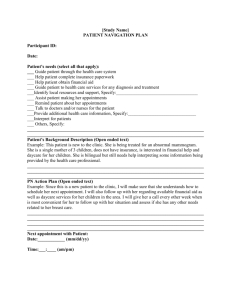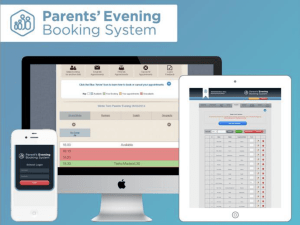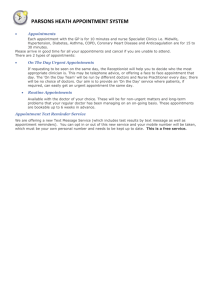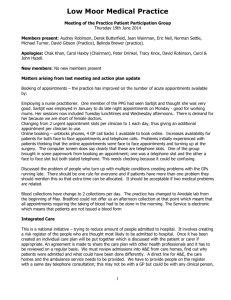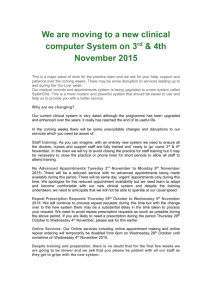12-11-12 MBE Control Tower Paper v2.5 Final
advertisement
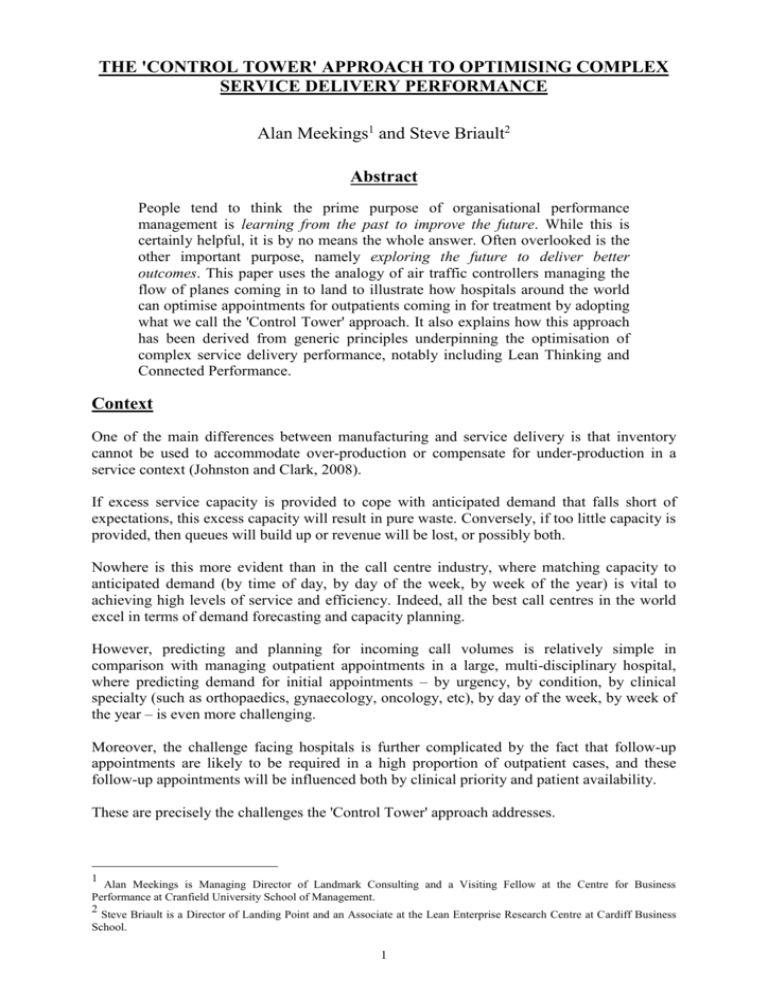
THE 'CONTROL TOWER' APPROACH TO OPTIMISING COMPLEX SERVICE DELIVERY PERFORMANCE Alan Meekings1 and Steve Briault2 Abstract People tend to think the prime purpose of organisational performance management is learning from the past to improve the future. While this is certainly helpful, it is by no means the whole answer. Often overlooked is the other important purpose, namely exploring the future to deliver better outcomes. This paper uses the analogy of air traffic controllers managing the flow of planes coming in to land to illustrate how hospitals around the world can optimise appointments for outpatients coming in for treatment by adopting what we call the 'Control Tower' approach. It also explains how this approach has been derived from generic principles underpinning the optimisation of complex service delivery performance, notably including Lean Thinking and Connected Performance. Context One of the main differences between manufacturing and service delivery is that inventory cannot be used to accommodate over-production or compensate for under-production in a service context (Johnston and Clark, 2008). If excess service capacity is provided to cope with anticipated demand that falls short of expectations, this excess capacity will result in pure waste. Conversely, if too little capacity is provided, then queues will build up or revenue will be lost, or possibly both. Nowhere is this more evident than in the call centre industry, where matching capacity to anticipated demand (by time of day, by day of the week, by week of the year) is vital to achieving high levels of service and efficiency. Indeed, all the best call centres in the world excel in terms of demand forecasting and capacity planning. However, predicting and planning for incoming call volumes is relatively simple in comparison with managing outpatient appointments in a large, multi-disciplinary hospital, where predicting demand for initial appointments – by urgency, by condition, by clinical specialty (such as orthopaedics, gynaecology, oncology, etc), by day of the week, by week of the year – is even more challenging. Moreover, the challenge facing hospitals is further complicated by the fact that follow-up appointments are likely to be required in a high proportion of outpatient cases, and these follow-up appointments will be influenced both by clinical priority and patient availability. These are precisely the challenges the 'Control Tower' approach addresses. 1 Alan Meekings is Managing Director of Landmark Consulting and a Visiting Fellow at the Centre for Business Performance at Cranfield University School of Management. 2 Steve Briault is a Director of Landing Point and an Associate at the Lean Enterprise Research Centre at Cardiff Business School. 1 The term 'Control Tower' derives from the analogy of managing planes coming in to land at busy airports, where the flow of incoming planes needs to be optimised bearing in mind factors such as runway capacity, terminal capacity and urgency of landing (with some planes potentially running dangerously low on fuel). Imagine what would happen if: Air traffic controllers were unable to see on radar the planes they were supposed to be controlling; Multiple air traffic controllers could decide whether and when specific planes were authorised to land; Pilots (or passengers) were allowed to decide when they felt like landing; and Airport directors made landing slots available solely on the basis of minimising operating costs. Doubtless, in these circumstances, no one would voluntarily fly in today's crowded skies. So, why should we accept a sub-optimal approach to managing hospital outpatient appointments, where the health and lives of people is at stake? Sadly, for instance, it is still not uncommon in National Health Service (NHS) hospitals in the UK for: People who book outpatient appointments to have no visibility of incoming demand; Lots of people to have the authority to change when patients are seen: Up to 30% of outpatient appointments to be cancelled by hospitals (then have to be rebooked); Clinics being chronically over-booked on some days and under-booked on others; Clinicians and patients choosing to ignore optimal flow and efficiency in favour of whatever happens to suit them best; and Hospital directors arbitrarily reducing outpatient slots simply to meet short-term budget targets, regardless of clinical needs and opportunities for systemic optimisation. How might the principles underpinning effective organisational performance management help in the context of optimising complex service delivery performance in general and hospital outpatient appointments in particular? Organisational Performance Management First, we need to reflect on the broader question, "Why do we seek to measure and manage performance in organisations in any case?" Clearly, one of the main reasons is to learn from the past to improve the future. This addresses several issues, such as: where are we now; what do we need to do differently; where do we aspire to be by when; and how are we progressing in terms of achieving our aspirations? However, there is another, less well-known reason, namely to explore the future to deliver better outcomes. While both these perspectives are important, applications of exploring the future to deliver better outcomes are seldom seen in practice. The Control Tower approach to optimising complex service delivery offers an instructive example. 2 For instance, in the context of managing hospital outpatient appointments, there is clearly a role for learning from the past to improve the future. Indeed, it is essential to monitor and learn from appropriate performance indicators, such as: Waiting times – by clinical specialty, by consultant, by first and follow-up appointments, by week of the year, and so on; Slot utilisation (i.e. the percentage of appointments wasted by under-booking); Over-booking and its downstream impact on waiting times in clinics; Hospital cancellation rates (i.e. the percentage of booked appointments subsequently cancelled by the hospital, rather than by the patient); and Patient non-attendance, typically measured by the 'Did Not Attend (DNA)' rate. However, bearing in mind that, in a service delivery context, over-production cannot be stored in inventory (and hence is irretrievably wasted if not consumed) and under-production simply builds longer queues (and hence results in longer waiting times), exploring the future to deliver better outcomes is equally important, if not more so. So, let us explore in more detail the application of organisational performance management principles in the specific context of optimising outpatient appointments, beginning by outlining the challenge. The Challenge of Optimising Outpatient Appointments Hospitals, worldwide, face the ongoing challenge of optimising outpatient appointments, balancing minimal delays and clinical priorities on the one hand against maximum efficiency on the other, in the context of financial constraints. Indeed, recent experience in the UK is especially instructive, as excessively long waiting times for outpatient appointments was a major political issue as far back as 1997, when the former Labour Government was first elected. It was not unusual, back then, for patients in the NHS to have to wait in excess of 17 weeks to attend initial hospital appointments. In response, the incoming Labour Government set a national target for reducing waiting times, specifying that all patients referred by a General Practitioner (GP) had to be seen by a hospital consultant within 17 weeks of referral. In practice, even this seemingly excessive waiting time for an initial outpatient appointment proved extremely difficult for most hospitals to achieve. Data shows that, whereas significant improvements in reducing waiting times, from GP referral to initial consultant appointment, were eventually realised across the UK (albeit at massive extra cost), waiting times for follow-up appointments did not improve correspondingly. Indeed, there is evidence that some hospitals sought to achieve the 17-week target by deferring follow-up appointments to indeterminate dates in the future, because waiting times for follow-up appointments were not subject to the 17-week national target. The Government responded by tightening their initial target from a maximum of 17 weeks from referral to first consultation to a maximum of 18 weeks from referral to first treatment. However, follow-up appointments remained excluded from this revised target. 3 Typically, this new referral to first treatment target implied that patients would need to be seen by a consultant within a maximum of 13 weeks from referral (and often sooner, especially in cases where appointments for diagnostic tests were required), in order that patients could then receive their first treatment within the revised maximum of 18 weeks. In addition to investing extra money in increasing hospital outpatient capacity – for instance, in paying hospital consultants to attend emergency 'Waiting List Initiative' clinics at overtime rates and setting up call centres to arrange initial and repeatedly amended bookings – other initiatives were launched at national level, the most significant and expensive of which was the National Programme for IT (known as 'NPfIT'). Under the banner of NPfIT, huge sums of money were invested in creating an IT-enabled capability called 'Choose & Book'. The thinking behind Choose & Book was that, when a patient was in a consulting room with their GP (in primary care) and their GP deemed it sensible to refer them for specialist attention (in secondary care), then the patient would be offered on the GP's computer screen: Multiple options concerning which consultant to see at which hospital and when; alongside Supporting data concerning mortality rates, hospital appointment cancellation rates, costs of car parking, and sundry other factors. The idea was that GPs would then advise their patients on the various options on offer, involving differing consultants, differing hospitals and differing availability dates, so that patients could make an informed choice. This choice would then instantly be locked into place and confirmed online – hence the title Choose & Book. At face value, this would seem to be a sensible approach. However, one of its fundamental problems (even assuming the underpinning software had worked as originally intended) is that it undermines the ability of hospitals to manage the flow of their work across specialist consultants for both initial and follow-up consultations. Why senior managers in the NHS did not immediately spot this obvious problem at the outset is now lost in the mists of time. Unfortunately, by stressing 'patient choice', which most observers agree is illusory (as evidence shows the overwhelming majority of patients simply want to be seen locally and as soon as possible), a seemingly well-meaning national initiative actually worked against the desired objective of reducing waiting times from referral to treatment. Even 15 years on from 1997, it is still not unusual in the NHS for up to 45% of pre-booked outpatient appointments not to happen as planned, because: Hospitals cancel (and subsequently have to re-arrange) up to 30% of booked appointments; and Up to 15% of patients choose not to attend their booked appointments. This constitutes avoidable waste on a truly massive scale. Can you imagine a lean organisation, like Toyota, failing to deliver up to 30% of its cars when promised or up to 15% of their customers failing to turn up to collect the cars they had 4 previously ordered? Frankly, this is inconceivable. Yet, the manufacture and delivery of cars is at least as logistically complex as arranging outpatient appointments in hospitals. It has been argued that one reason why such a high percentage of NHS patients do not bother to attend their hospital outpatient appointments is because the NHS offers treatment free-ofcharge, and hence patients have no financial incentive to attend. However, it is sensible to ask if there is any evidence to support this assertion. The unequivocal answer is 'no'. Actually, things look very different when seen from a patient's perspective. For instance, consider how committed you would be to attending a hospital outpatient appointment, fixed for yet another inconvenient time arbitrarily dictated by the hospital, if you had already experienced several previous cancellations? The sad fact is that the process of managing hospital outpatient appointments in the UK has improved very little over the past two decades, during a period when massive sums of taxpayers' money were invested in seeking to reduce waiting times. Are we forced, therefore, to conclude that managing outpatient appointments in the NHS is somehow 'one of life's fundamentally intractable problems' or might there actually be a better way forward? A Better Way Forward Before considering the basis of a better way forward, there are two important factors to bear in mind when looking at how to optimise outpatient appointments: (1) The variety in presenting symptoms and individual patient circumstances; and (2) Clinical capacity. Variety While the analogy between planes coming into land at airports and patients being scheduled for outpatient appointments in hospitals is interesting, greater variety needs to be accommodated in the hospital context, not least because: Airports have a fixed number of runways, fixed hours of operation and other relatively inflexible operational constraints. Hence they have fixed limits on the number of landing slots available. This is not the case with outpatient appointments in hospitals, where the number and timing of outpatient clinics can be varied, at least to some extent, by time of day, day of the week and week of the year, given the co-operation of consultants and appropriate availability of supporting diagnostics and other hospital facilities. Flight schedules are arranged and publicised many months in advance, and change only infrequently. In contrast, the volume and mix of patients needing to be seen by hospital consultants varies significantly. This means the performance planning process for outpatient appointments needs to be capable of handling significant variety and the challenge is to match varying demand within a relatively fixed structure of provision, given that: NHS hospitals will typically have clinics with standard templates comprising a fixed number of slots of one or more types of appointment (routine, urgent, new, follow-up, with or without diagnostic provision, etc); and 5 Capacity varies both predictably and unpredictably, due to the absence of clinicians, problems with facilities, and sundry other factors (see Figure 1). Balancing Demand and Provision Structure of provision: Profile of demand: • Templates/slots • Volume • Mix of appointment types • Mix of need and condition Variation: • Daily/weekly Shorter waiting times demand greater flexibility NR NR NR NR NR NR NR NR NR NR NR NR NR NR NR NR NR NR NU NU NU NU NU NU FU FU FU FU FU FU FU FU FU FU FU FU Variation: • Seasonal • Statutory holidays • Common and special causes • Consultant availability • Trends • Wider clinical availability Key to appointment types: NR = New Routine; NU = New Urgent; FU = Follow-Up Figure 1. Balancing Demand and Provision in Outpatient Appointments Clinical Capacity Two key factors significantly affect clinical capacity in NHS hospitals: (1) Consultant availability; and (2) Wider clinical availability. Let us look at each of these factors in more detail. Consultant Availability NHS hospital consultants are contractually obliged to give notice of non-availability for outpatient appointments six weeks in advance. Beyond this six-week threshold period, they have personal discretion around when to take holidays, study leave, sabbaticals and so on. So, conceptually, if all outpatient appointments could be arranged within a six-week time horizon, then all these appointments should theoretically take place as planned. In reality, though, not all initial or follow-up appointments need to be scheduled within six weeks. For instance, although initial appointments for patients potentially suffering from cancer need to happen as soon as possible, other outpatient appointments (especially followup appointments) often need to be set at intervals longer than six weeks for sensible clinical reasons, such as the need to observe how initial treatments are working in practice. On most Patient Administration Systems in the NHS, clinics are assumed to run for 52 weeks a year. In practice, they probably run for between 40 to 42 weeks a year. This implies that any appointment booked more than six weeks in advance has a roughly 20% chance of being cancelled by the hospital. 6 Wider Clinical Availability The reality is that the timing of referrals from GPs exhibits high variability – by day of the week, by week of the year and by clinical specialty. In contrast, the clinical capacity provided in hospitals, in terms of doctors, nurses and facilities, tends to be roughly constant across the whole year (except overnight, at weekends, on national holidays and during popular holiday periods). Hence, the difference between demand and capacity needs to be managed actively. How to Cope with These Two Factors One important advance in these circumstances, previously frowned upon by the NHS but now widely recognised as best practice, is to make 'partial bookings' for patients. If, for example, a patient does not need to be seen within the six-week window, they can be put onto a schedule for an appointment more than six weeks in advance, with a firm booking made nearer the time. Imagine a conversation between an outpatient clerk, working in a hospital that operates partial bookings, and Mrs Jones, a patient requiring another orthopaedic appointment, going along the following lines: "I understand that Mr Smith would like to see you again in three months time. Would sometime during week commencing Monday 16th July be convenient for you? Very good. I'll send you a letter about six weeks in advance, inviting you to give us a call to agree a convenient time for your appointment that week. Would this be OK for you? Excellent. Is there anything else you need to ask me at this stage?" Once the process of managing initial and follow-up outpatient appointments is under control, then partial booking works extremely well. Specifically, partial booking allows the availability of consultants to be matched against the clinical needs and personal convenience of patients. Clinicians who may initially be sceptical about the potential benefits of partial booking have been convinced by powerful evidence regarding the correlation between DNA rates and elapsed times between booking dates and appointment dates (see Figure 2). Perhaps unsurprisingly, this data shows that the longer ahead appointments are booked, the less likely patients are to attend. For instance, during the interim between booking and appointment dates, patients may forget their appointments, move out of the area, recover or even, sadly, die. 7 Figure 2. Correlation between Booking Dates and DNA Rates Hence, partial booking, with appointments confirmed six weeks in advance, achieves an optimal balance between giving patients sufficient notice to plan their attendance (and not forget their appointment), and being able to give them appointments that will almost never be cancelled by the hospital. Moreover, and perhaps counter-intuitively, partial booking also enables the concept of Choose & Book to work well for patients, as the Control Tower approach, operating in the background, enables capacity to be flexed to deliver an appropriate mix of appointments (matching predictable demand for differing types of appointment) up to the six-week booking horizon. The implications are as follows: Clinicians and administrative staff must jointly manage outpatient bookings; There needs to be clear visibility of future demand, by clinical specialty, not just for agreed follow-up appointments but also for incoming initial consultations; Predictable demand for associated diagnostics, such as X-Rays, must be planned in advance with equal rigour; and Current and predictable future performance must be made explicit and widely visible. Before describing the Control Tower approach in more detail, we first need to set it in the context of the overall approach to organisational performance management that we call 'Connected Performance', and explain how it relates. Connected Performance How many organisations have you encountered who seem to think that all there is to improving organisational performance is to track and react to a 'balanced scorecard' of performance measures, based on data presented in tabular format? Unfortunately, many NHS hospitals still think this way. 8 This view of organisational performance management is limited for several reasons, not least because: (1) Performance information can, and should, come in appropriate guises, not just in tables of numbers and spreadsheets. For instance, the visual presentation of performance information is often essential for enabling actionable insights to emerge; (2) Having access to relevant performance information is necessary but by no means sufficient; and (3) The real value of performance information lies in the quality, timeliness and integration of decision-making and action-taking up, down and across organisations. In our view, four elements are essential to deliver effective organisational performance management, and we call this combination Connected Performance3 (see Figure 3). Figure 3. The Essential Elements of Connected Performance Connected Performance comprises: A Performance Architecture that specifies: (a) who needs to look at what performance information, why, when, where and how; and (b) how various functions and levels of management best interconnect and interrelate up, down and across the organisation; A Performance Exploration capability that allows people to explore relevant performance data 'at the speed of thought' (in other words, as soon as a question comes to mind, rather like Googling for information on the Internet as questions occur). Recent advances in technology, especially over the past decade, now make this both achievable and affordable; A Performance Planning process that translates insights from performance information into appropriate, timely decisions, actions and downstream learning4; and 3 A fuller description of Connected Performance can be found in a paper presented at the international Performance Measurement Association (PMA) conference in July 2012 (Meekings, Povey and Neely, 2012). 4 The concept of systematically improving the performance planning process in organisations was first articulated in a paper presented at the international PMA conference in 2004 (Meekings, 2004). 9 A Performance Culture that avoids 'analysis paralysis' and actively encourages engagement, action, learning, experience-sharing and 'the pursuit of perfection'5. This systemic organisational performance management framework applies across the healthcare industry, including: Whole organisations, such as hospitals of any size; Whole healthcare systems, such as the Emergency Care system (encompassing GP services, out-of-hours services, ambulance services, minor injury clinics, hospital emergency departments and community care); and Specific processes, such as managing outpatient appointments (as featured in this paper). So, how does Connected Performance apply specifically to the management of outpatient appointments6? Clearly the first step is to design and implement an appropriate Performance Architecture. In the context of managing outpatient appointments, this implies that: (a) Someone needs to take single-point accountability for slot planning, based on clear visibility of demand and capacity; and (b) Decisions need to be taken by a combined clinical and administrative team, including the involvement of a clinical lead empowered to make decisions on behalf of other consultants in his or her clinical specialty. The second step is to address the concept of Performance Exploration. This requires providing the combined management team with visibility of: (a) Relevant past-performance metrics (such as waiting times, hospital cancellation rates and patient non-attendance); (b) Forecast and actual demand for incoming and follow-up outpatient appointments; and (c) Detailed information on predictable capacity, including factors such as the availability of doctors, nursing staff, supporting therapists, consulting rooms, reception staff, slots for X-rays, other diagnostic services and so on. In this context, it is worth mentioning that the charting and analysis of data using Statistical Process Control (SPC) techniques can be hugely helpful. Not only does this approach highlight daily variation, weekly cyclicality, annual seasonality and statistically significant trends (both in terms of demand and performance) but also it enables root causes to be explored in a way that would otherwise be far too time-consuming to be feasible. Then a proper Performance Planning process needs to be established. Unfortunately, there are several reasons why effective performance planning is not currently commonplace across the NHS, notably: 5 Henry Royce, of Rolls-Royce Motors fame, was one of the first and most passionate advocates of 'the pursuit of perfection'. As he frequently urged his workforce, "Strive for perfection in everything you do. Take the best that exists and make it better. When it does not exist, design it." (Sir Frederick Henry Royce, British engineer, 1863-1933). 6 General issues associated with implementing a systemic organisational performance management framework, such as Connected Performance, are addressed in a paper presented at the international PMA conference in 2006 (Meekings and Povey, 2006). 10 (1) People are unfamiliar with the skills associated with exploring the future to deliver better outcomes, including: (a) reliably predicting demand at least 6 to 8 weeks into the future; and (b) team-based problem-solving; (2) The unwillingness of clinicians and administrators to take decisions jointly; (3) The limited ability of hospitals to make decisions that actually stick and are not subsequently overturned or ignored. This relies heavily on lead clinicians being able to secure the backing of their clinical colleagues. Fortunately, this becomes much easier as soon as clinicians start to see the benefits of adopting the Control Tower approach; and (4) The lack of visibility of upcoming demand and capacity. Patient Administration Systems in NHS hospitals typically do not readily display an overview of available slots for particular specialties. The Control Tower approach involves developing a planning dashboard to meet this need, so that decision-makers can instantly see how capacity is matched to demand over future weeks. Each of these issues needs to be addressed rigorously. Finally, a vibrant Performance Culture has to be established. This depends critically on how participants behave in performance planning sessions in terms of adhering to a welldeveloped set of behavioural Dos and Don'ts. The Control Tower Approach The Control Tower approach emerged from pilot applications of 'Lean Thinking' in hospitals7, from which it became clear that the management of patient flow was essential but that there were no methods for achieving this. The challenge was to manage flow in real time and apply the principle of pull to ensure the right clinic slots were provided at the right time to meet the needs of individual patients. The Control Tower approach is based around a weekly slot-planning session, in which clinical and administrative staff jointly preview an upcoming six-to-eight week period, looking at clinic slots booked and available (including predictable increases and reductions in demand and capacity) alongside lists of appointments over this time window. Joint decisions are taken around flexing capacity to match real-time patient needs. The first step in implementation is to hold an initial demand profiling and capacity planning session, during which a shared clinical and administrative perspective is built around anticipated demand and capacity for the year ahead (with any necessary adjustments to planned provision being agreed in the light of this picture). Types and degrees of flexibility are also agreed regarding the adaptability of short-term provision in the light of emerging demand. Requirements for setting up this capability include: (1) The engagement and support of clinicians, staff and managers working together to improve their service; (2) The capability to flex provision by converting slots and either extending or reducing clinic times, as necessary; (3) Partial booking for appointments required more than six weeks ahead; and 7 For descriptions of 'Lean Thinking' applied to service industries and healthcare, see Fillingham (2008) and Jones and Mitchell (2006). 11 (4) Creating a visual dashboard presentation8 of all the vital information needed to optimise appointments through the booking horizon (typically 6-8 weeks out) and covering: Numbers of new and follow-up patients waiting to be seen – by clinical specialty, by appointment type, by urgency, by consultant, by upcoming week; Slots booked and available for each upcoming clinic; and Any constraints regarding capacity provision, such as planned staff absence. The agenda for a typical Control Tower planning session will cover: (1) Performance over the previous week (for instance, patients seen versus plan, DNAs and cancellations); (2) The latest waiting list situation, and any foreseeable demand management issues; (3) Previewing each forthcoming week up to the booking horizon, noting: Slots booked and slots available in that week; New patients to be seen; Follow-up patients to be seen; Decisions on adjustments to planned provision for that week (slot conversions, staffing, etc), applying the pull principle; and Decisions to allocate patients to specific slots (to be implemented by the specialty booking clerk), thereby creating flow. (4) Any medium-term capacity issues, such as staff turnover. Standard Operating Procedures ensure that necessary disciplines concerning the preparation and conduct of Control Tower planning sessions and the subsequent implementation of decisions are embedded across all clinical specialties. The Control Tower approach has been implemented in several NHS hospitals and across all clinical specialties, including surgery, medicine, diagnostics and paediatrics. Every application has delivered significant benefits. For illustrative purposes, we will now describe one representative Control Tower project. A Representative Control Tower Project One early Control Tower project was led by the Operations Director of a large hospital in central England. In this particular case, the Operations Director chose to pilot the Control Tower approach in just one clinical specialty, namely Ear, Nose and Throat (ENT), with a view to using emerging measurable benefits from this experience as the basis for persuading other clinical specialties to follow suit. This approach proved highly successful. What this pilot project demonstrated was that, despite thinking to the contrary prevalent across the NHS, it was actually feasible within a few months to: (1) Achieve waiting times of under six weeks; (2) Essentially eliminate hospital cancellations; 8 Ideally, this dashboard facility should be enabled electronically and should provide the capability for actions agreed at Control Tower planning sessions to be captured quickly and accessed easily afterwards. 12 (3) Improve slot utilisation from typically 85-90% to over 95%, representing hundreds of extra appointments and tens of thousands of pounds in financial savings per specialty in a typical NHS hospital; (4) Reduce rates of patient non-attendance (i.e. DNA rates) from 10-15% to less than 5% (which is probably close to an irreducible minimum, given that unexpected things happen in people's lives); and (5) Ensure that follow-up appointments are offered to patients within five days either side of clinically-optimal timing, thus significantly improving service quality and clinical outcomes. While the immediate results of this pilot project were striking, it still took some time for the whole hospital to embrace this approach. Obviously, the Control Tower approach can challenge organisational habits established over many decades and hence may require an investment of time and attention from clinicians and staff, who are likely already to feel overstretched, in order to make it happen. However, within a few months, as participants became increasingly familiar with this approach, decisions became easier, quicker and much less time-consuming. This, in turn, led to improved patient and clinician experiences and an overall reduction in managerial time, as clinic loadings were optimised. Initially, though, cultural inertia, long-standing prejudices (for example, regarding partial booking) and vested interests (for example, with some consultants actually welcoming extra income from 'Waiting List Initiative' clinics) can create resistance. Hence, top-level support is essential in the early days. With this particular pilot project, the sustained belief and active support of the Operations Director was hugely helpful. Barriers to Implementation The obvious downside to adopting a piloting approach is that this inevitably delays the realisation of benefits across the whole hospital. Given the proven benefits of the Control Tower approach, it is sensible to ask, "Why would NHS hospitals not rush to embrace it across all specialties from the outset?" One reason could be that uncertainty around the future structure of the NHS, introduced by the current Coalition Government, may be distracting the attention of clinicians and managers away from fundamental improvement towards personal worries about redundancy and future employability. Other reasons could include: Clinicians being overly protective of their own autonomy; Administrative staff feeling thoroughly 'change-weary'; and Partial booking being seen as little more than a palliative measure (and extra work for hospital staff in the short-term), rather than as an essential step towards balancing demand and capacity. Experience suggests that radical improvements in managing outpatient appointments, using the Control Tower approach, are unlikely to happen unless: Either the hospital's Chief Executive, or Operations Director, or both are genuinely enthusiastic and actively supportive; 13 At least one hospital Clinical Lead is passionate about tackling the issue of optimising outpatient appointments through the application of new thinking; and There is a willingness to make the necessary performance and planning information available. Moreover, it is important to recognise that moving from substantial queues and delays to a sustainable, dynamic balance between demand and capacity is a bit like the analogy of 'draining the swamp'. All sorts of rocks will emerge and need to be removed as the swamp is progressively drained. For instance, there are often problems around making patient records available, arranging diagnostics in advance, and making consultants and nursing staff available. Fortunately, as each challenge is met and resolved, performance improves and everyone notices – patients, clinicians, nursing staff, support staff and administrators alike. Lessons Learned Key lessons learned from our experience with the Control Tower approach are that: Joint commitment from clinicians, managers and administrators is essential; Existing IT systems can be among the biggest obstacles. Determination and persistence are needed to find ways of overcoming apparent constraints in the provision of vital planning and performance information; The development of a teamworking culture within clinical specialties is an important success factor; Crude quantitative targets can work against a genuine patient orientation; and Flexibility of provision, in the light of visible real-time demand, is essential for optimising both efficiency and clinical quality. Conclusions In this paper, we have described the contribution of Connected Performance not only to learning from the past to improve the future but also to exploring the future to deliver better outcomes, as illustrated in the Control Tower approach to optimising hospital outpatient appointments in particular. Clearly, the principles outlined in this paper apply generically to optimising complex service delivery performance, not only with appointment-based services but universally. We believe our experience is sufficiently significant to merit further academic research regarding our approach and our empirical findings, and we would enthusiastically welcome such research, ideally in the form of longitudinal studies before, during and after implementation. References Johnston, R. and Clark, G. (2008). "Service Operations Management: Improving Service Delivery", FT Prentice Hall, 3rd Edition. Meekings, A (2004). "Getting The Most Out Of Performance Measurement". In Andy Neely, Mike Kennerley and Angela Walters (Ed.), Performance Measurement and Management: 14 Public and Private, Papers from the Fourth International Conference on Performance Measurement and Management – PMA, July 2004, pp 1141-1148, CBP, Cranfield. Meekings, A, and Povey, S (2006). "'Plumbed-In Performance Improvement': Accelerating Improvement and Adaptation in Organisations", In Andy Neely, Mike Kennerley and Angela Walters (Ed.), Performance Measurement and Management: Public and Private, Papers from the Fifth International Conference on Performance Measurement and Management – PMA, July 2006, pp 1047-1054, CBP, Cranfield. Meekings, A, and Povey, S and Neely, A (2012). Connected Performance: A New Approach to Organisational Performance Management, in Performance Management: From Strategy to Delivery, electronic Proceedings from the Seventh International Conference on Performance Measurement and Management – PMA, July 2012 (downloadable at http://bit.ly/VjkzCs). Jones, D and Mitchell, A (2006). Lean Thinking for the NHS. NHS Confederation, London (downloadable at http://bit.ly/POF90K). Fillingham, D (2008). Lean Healthcare: Improving the Patient’s Experience. Kingsham Press, Chichester. 15

